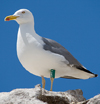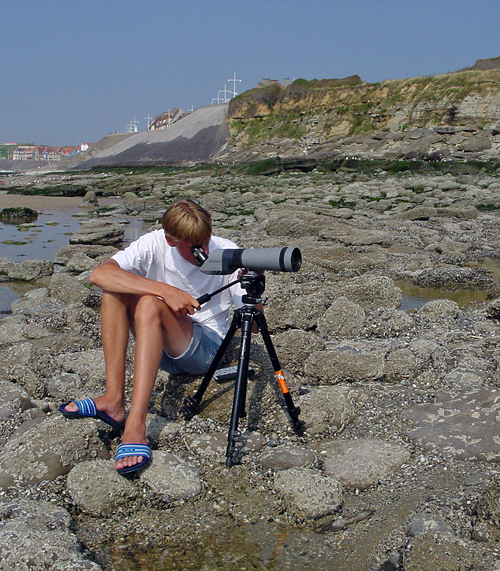 Yellow-legged
Gull - Larus michahellis
Yellow-legged
Gull - Larus michahellis
(last update: October 08 2013)
Coordinators:
Delfín González
Gabriel Martín
Antonio Gutierrez
Amir Ben Dov
Mars Muusse
Larus michahellis - adult July
|
This website deals with the Yellow-legged Gull taxon michahellis, which is a common migrant from July to December in NW Europe. After extensive expansion of the breeding population during the last three decades, it nowadays can be found breeding in Belgium, the Netherlands and Britain in mixed couples with both Herring Gull (argenteus) and Lesser Black-backed Gull (graellsii). There are subtle differences between the populations from the Mediterranean, Atlantic coast of Portugal and Morocco and from the islands in the Atlantic. Most pronounced differences can be found in the taxon atlantis, now regarded as full species by some authors and birds along the Atlantic coast of the Iberian peninsular: lusitanius. Both atlantis and lusitanius are treated in their own sections on this website.
General description
Early July and from July 26-30 2001 we did small surveys on Yellow-legged Gulls at Le Portel (near Boulogne-sur-Mer) and Etaples (near Le Tourquet). In these surveys, we scored moult stages to determine timing of moult in primaries (and wing- coverts and body-feathers) in adult michahellis. Adult michahellis is readily easy identified by July, as only limited adult Herring and Lesser Black-backed Gulls are present.
For details on differences between michahellis and cachinnans, see e.g. the article by R. Klein & D. Gruber in Limicola, April 1997.
Moult of remiges and rectrices in July
The tables below show
the moult progress in a two week interval at Etaples, near
Boulogne-sur-Mer, NW France (click here to find maps of locations and pictures of Le Portel surroundings). In the
second week of July, the adult michahellis primary score is
slightly over 6: 6.3 in the first table. By the end July, primary moult
continues, only leaving the outer four or five primaries unshed. It's hard
to draw any conclusions about the moult stage of new grown primaries in
July, as in most birds the exact primary moult score could not be
established. However, the score of remaining old primaries was established
at 2.4, with n = 106, weight SD = 0.63, July 28-29 2001 at Etaples. The
very narrow range of moult scores (expressed by the low SD value) is one
of the most striking characteristics when scanning a group of michahellis.
The spread around the mean value is often near perfect and in this respect
differs strongly from e.g. Lesser Black-backed Gull, which has
high SD values, in many cases caused by a mix of different populations.
For more details on LBBGs, click
here. A gap of three primaries is common in adults, as can be
found in the tables as well; e.g. P4 fully grown, P5 almost fully grown,
P6 almost at half of the final length, P7 just shed and P8 still old.
The secondary moult is just not started by the end of July. In immatures
the secondary score is slightly advanced compared to adults and by the end
of July, third calendar year michahellis drops the 2nd,
3rd and 4th secondaries (the outermost secondaries).
Near adults (4CY birds) are similar in moult pace to the adults and
normally show a complete secondary row. The same is true for the rectrices. Normally, adults show a complete tail throughout July
while average 3CY michahellis drop the central tail-feathers by the end
of July.
Moult in the wing coverts
Normally, adult michahellis do not
include wing-coverts in the partial pre-breeding moult in spring. Consequently, the
coverts start to show extensive wear by June; and by early July feathers
can be very abraded. The feathers most vulnerable for wear are the upper
tertials, the inner coverts and the rear lower scapulars. As can be seen
in some of the images, e.g. image 12 and 10, some tertials and greater
coverts have the top half strongly reduced, leaving only a protruding
shaft-streak in some feathers.
By July, some adults still have present all the
abraded coverts, showing no gaps in the covert rows (see
e.g. image 5). Other
adults start moult, dropping the inner greater coverts and innermost
and outermost median coverts. Adults with new median coverts can be
found at Le Portel by early July as can be seen in image 4.
The lesser covert moult sequence is more
difficult to fully understand as feathers of this tract are dropped
randomly. The start of greater covert moult is pretty obvious, as suddenly
the white-tipped secondaries can be seen from underneath the greater
coverts. Normally, those secondaries are hidden completely.
By the end of
July, the vast majority of adult michahellis have started
wing-covert moult and may look very messy: the old retained feathers are
very abraded and quite some feathers have been dropped, resulting in
various moult gaps.
Timing and strategy of body & covert moult in July
In line with other large white-headed gulls in NW Europe, most obvious body feather moult starts with the head feathers around the eye and the flank feathers (see image 5). From the end of June and throughout July, feathers are dropped in the area around the eye and leaves the skin naked. The red orbital ring becomes even more obvious. Most other body feathers are retained and especially the flank feathers may look very abraded.
See the Topography Section for explanation of feather tracts.
Tables
| Adult michahellis remaining old primaries, July 11 2002 Etaples, NW France. n = 66, m = 6.3, SD = 1.03 | |
| P4 / <P5 old | 4 |
| P5 old | 7 |
| P6 old | 29 |
| P7 old | 19 |
| P8 old | 6 |
| P9 old | 1 |
| P4 / <P5 old: at least P5-P10 are still old and these scores are added by the definite P4-P10 birds. Those <P5 birds refer to sleeping adults. | |
| adult michahellis remaining old and fully grown new primaries, July 28 2001 Etaples. | ||||||
| p? | p3 new | p4 new | p5 new | p6 new | n = | |
| p6 old | 1 | 1 | ||||
| p7 old | 14 | 2 | 4 | 20 | ||
| p8 old | 14 | 3 | 5 | 4* | 26 | |
| p9 old | 1 | 1 | 2 | |||
| p10 old | 1 | 1 | ||||
m
(average): 2.4 remaining old primaries, SD = 0.69 |
||||||
| adult michahellis remaining old and fully grown new primaries, July 29 2001 Etaples. | ||||||
| ? | p2 new | p3 new | p4 new | p5 new | n = | |
| p7 old | 16 | 1 | 2 | 3* | 22 | |
| p8 old | 20 | 8** | 3*** | 31 | ||
| p9 old | 2 | 1 | 3 | |||
m
(average) = 2.3 remaining old primaries; SD (standard deviation
value) = 0.58. |
||||||
| adult michahellis scores: Lignano, Venice July 27 - 29 2001. | |||||||||||||||
| prim* score | 18 | 19 | 20 | 21 | 22 | 23 | 24 | 25 | 26 | 27 | 28 | 29 | 30 | 31 | 32 |
| 3 | 5 | 4 | 9 | 8 | 19 | 33 | 28 | 46 | 22 | 13 | 5 | 8 | 9 | 4 | |
| n: 216, m: 25.3, SD: 2.88 | |||||||||||||||
| fully** grown | p0 | p3 | p4 | p5 | p6 | ||||||||||
| 6 | 9 | 75 | 114 | 18 | n: 222 | m: 4.53 | SD: 1.02 | ||||||||
| About 75% is missing the complete median covert bar. | |||||||||||||||
| About 25% is missing / moulting tail-feathers. | |||||||||||||||
*: prim score =
primary moult score, see Topography for explanation. However, in
this table a different score was used, with shed feathers scoring
0. So, both old feathers and recently shed feathers score 0, fully
grown feathers score 5, still the primary score runs from 0 to 50. |
|||||||||||||||
This table presents the results of a research done in the same period at Lignano, near Venice. As can be read from the table, adults in this region are ahead in primary moult-score compared to the birds from NW France. In line with what can be expected, moult in the rectrices is advanced as well, with about 25% moulting the tail-feathers. The moult of rectrices starts about a week or 10 days later at Le Portel (in the first week of August).
 Yellow-legged
Gull lusitanius 2CY, 7CY & 8CY AJ1N 2006, 2011 & 2012, Gijón, Spain.
Yellow-legged
Gull lusitanius 2CY, 7CY & 8CY AJ1N 2006, 2011 & 2012, Gijón, Spain. Yellow-legged
Gull lusitanius adult ZJM0 July 04 2007, Coruña, Galicia, Spain. Photo: Faustino Roura.
Yellow-legged
Gull lusitanius adult ZJM0 July 04 2007, Coruña, Galicia, Spain. Photo: Faustino Roura. Yellow-legged Gull (michahellis) 19CY-25CY C 53597Boulogne-sur-Mer, NW France. Picture: Jean-Michel Sauvage.
Yellow-legged Gull (michahellis) 19CY-25CY C 53597Boulogne-sur-Mer, NW France. Picture: Jean-Michel Sauvage. Yellow-legged Gull michahellis adult SKX3 July 20 2006, Leipzig, Germany. Picture: Jürgen Streudtner.
Yellow-legged Gull michahellis adult SKX3 July 20 2006, Leipzig, Germany. Picture: Jürgen Streudtner. Yellow-legged
Gull michahellis adult, July 09 2010, Maagan Michael, Israel. Picture: Gal Shon. Complete moult.
Yellow-legged
Gull michahellis adult, July 09 2010, Maagan Michael, Israel. Picture: Gal Shon. Complete moult. Yellow-legged
Gull michahellis adult, July 09 2010, Maagan Michael, Israel. Picture: Gal Shon. Complete moult.
Yellow-legged
Gull michahellis adult, July 09 2010, Maagan Michael, Israel. Picture: Gal Shon. Complete moult. Yellow-legged Gull michahellis adult, July 10 2008, Portalan, Switzerland. Picture: Stephane Aubry.
Yellow-legged Gull michahellis adult, July 10 2008, Portalan, Switzerland. Picture: Stephane Aubry. AE4F9905 TLV Uni. Zoo. Garden 9.7.11.jpg) Yellow-legged
Gull michahellis adult, July 09 2011, Tel Aviv - University Garden, Israel. Picture: Amir Ben Dov.
Yellow-legged
Gull michahellis adult, July 09 2011, Tel Aviv - University Garden, Israel. Picture: Amir Ben Dov. Mixed pair of michahellis x armenicus.
 Yellow-legged
Gull lusitanius adult, July 03 2010, Peniche, Portugal. Photo: António A. Gonçalves.
Yellow-legged
Gull lusitanius adult, July 03 2010, Peniche, Portugal. Photo: António A. Gonçalves. Yellow-legged
Gull michahellis adult, July 11 2002, Etaples, NW France. Typical adult.
Yellow-legged
Gull michahellis adult, July 11 2002, Etaples, NW France. Typical adult. Yellow-legged
Gull michahellis adult, July 11 2002, Etaples, NW France. All wing-coverts abraded.
Yellow-legged
Gull michahellis adult, July 11 2002, Etaples, NW France. All wing-coverts abraded. Yellow-legged
Gull michahellis group, July 27 2001, Etaples France. Wings raising adult
with P7-P10 still old and many outer greater and median coverts shed.
Yellow-legged
Gull michahellis group, July 27 2001, Etaples France. Wings raising adult
with P7-P10 still old and many outer greater and median coverts shed. Yellow-legged
Gull michahellis group, July 27 2001, Etaples France. An adult with P7-P10 still old, the greater coverts shed and the median coverts recently
replaced.
Yellow-legged
Gull michahellis group, July 27 2001, Etaples France. An adult with P7-P10 still old, the greater coverts shed and the median coverts recently
replaced. Yellow-legged
Gull michahellis group, July 27 2001, Etaples France. Three sub-adults
left and a wing raising adult with P7-P10 old.
Yellow-legged
Gull michahellis group, July 27 2001, Etaples France. Three sub-adults
left and a wing raising adult with P7-P10 old. Yellow-legged
Gull michahellis group, July 27 2001, Etaples France. Note the difference
in moult progress.
Yellow-legged
Gull michahellis group, July 27 2001, Etaples France. Note the difference
in moult progress. Yellow-legged
Gull michahellis 5CY?, July 27 2001, Le Portel France. Note the black
central markings on the primary coverts, a sign of immaturity.
Yellow-legged
Gull michahellis 5CY?, July 27 2001, Le Portel France. Note the black
central markings on the primary coverts, a sign of immaturity.